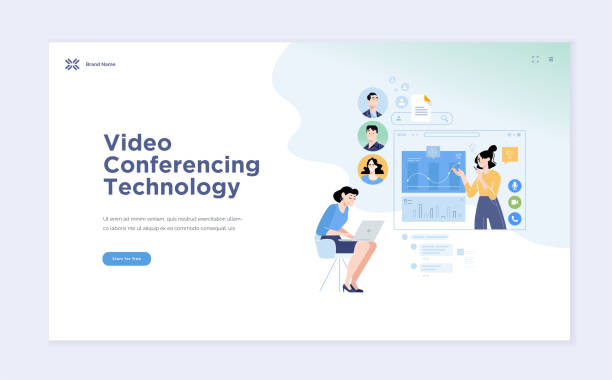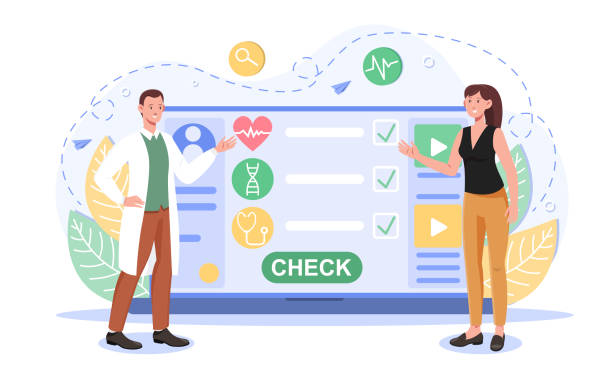Introduction to User-Friendly Website Design: Why is it Important?

In today’s competitive world, an online presence isn’t enough with just having a website. What truly makes a difference is the quality of the user experience (UX) your website provides.
User-friendly website design means building a website that not only looks beautiful but is also easy and enjoyable to use. This approach ensures that visitors can easily find what they need, understand information simply, and ultimately, achieve their goals.
A website built on the principles of user-friendly web design can significantly increase conversion rates, improve customer satisfaction, and strengthen brand loyalty.
To achieve this, a deep understanding of user behavior, their needs, and how they interact with the website’s user interface is of paramount importance.
This is not just a technical approach, but a strategic perspective for online businesses.
In fact, user-friendly website design is an investment in the future of your business.
Are you tired of losing business opportunities due to not having a professional corporate website?
Rasaweb helps you with professional corporate website design:
✅ Build a powerful and reliable image for your brand
✅ Convert website visitors into loyal customers
⚡ Get a free consultation now!
Key Principles of User Experience (UX) in Web Design

User experience, beyond visual appearance, addresses the user’s feelings and perceptions when interacting with a website.
This includes all aspects of the end-user’s interaction with the company, its services, and its products.
To create a user-friendly website design, six key UX principles must be considered: usability, usefulness, desirability, accessibility, credibility, and findability.
A website that adheres to these principles is not only efficient but also attractive and trustworthy for users.
For instance, usability means ease of task completion; can the user quickly fill out a form or find their desired product? Usefulness means providing content that addresses the user’s real needs.
A website with specialized and detailed explanatory content can help users solve their problems.
User-friendly website design, by focusing on these principles, ensures that every click, every scroll, and every interaction leads to a positive and constructive experience.
In fact, these principles are the main pillars of a successful and sustainable online presence.
The Importance of Visual Design and Layout in User Engagement

The visual design and layout of a website are the first things a user encounters and have a significant impact on their initial impression and decision to continue browsing.
An organized and visually appealing layout not only enhances aesthetics but also increases usability and guides the user through the site.
Colors, fonts, images, and white space (negative space) are all crucial components that must be carefully selected and combined to create a harmonious and pleasant experience.
For example, using corporate colors can help strengthen the brand, while legible fonts and appropriate text sizes increase readability.
Sufficient white space separates page elements and prevents visual clutter, which significantly aids in better content comprehension.
User-friendly website design with these elements strives to provide a clear and pleasant path for the user’s eye and prevent confusion.
Below, you will see a comparative table of effective visual design elements that can be instrumental in improving the visual quality of your website.
| Visual Element | Importance in User-Friendly Website Design | Key Points |
|---|---|---|
| Color Scheme | Creating Mood, Branding | Harmonious color palette, appropriate contrast for readability |
| Typography (Font) | Text readability and aesthetics | Legible fonts, appropriate size, visual hierarchy |
| White Space | Reducing clutter, focusing on content | Generous use of empty space between elements |
| Images and Icons | Visual appeal, conveying meaning | High-quality images, clear and relevant icons |
| Layout and Hierarchy | Guiding the user’s eye, organizing information | Logical grid, highlighting important elements |
Information Structuring and Intuitive Navigation

Navigation and Information Architecture form the heart of a user-friendly website design.
If users cannot easily find their way around your website and access the content they need, even the best content will be useless.
An intuitive navigation system means that users, without needing to think much, know where they are, where they can go, and how to get what they want.
This includes clear menus, logical internal links, the use of breadcrumbs, and efficient search.
Organizing content into logical categories and clearly labeling links and buttons are fundamental principles.
For instance, in an educational site, lessons should be categorized in a way that allows the user to easily progress from beginner to advanced levels.
Strong information architecture helps reduce the user’s cognitive load and prevents confusion.
User-friendly website design with this approach creates a smooth path for deeper user discovery and interaction with your website, which in turn leads to increased user retention and reduced bounce rates.
Is your company’s website as professional and reliable as it should be? With specialized corporate website design by Rasaweb, create an online presence that reflects your credibility and attracts more customers.
✅ Build a powerful and professional image for your brand
✅ Convert visitors into real customers
⚡ Get a free consultation now!
Responsive Website: The Necessity of Design for All Devices

In the current digital age, the variety of devices users employ to access the internet is vast; from small mobile phones to large desktop displays.
This has made the concept of Responsive Web Design a necessity.
A responsive website automatically adjusts its layout and elements to the user’s screen size to provide the best possible experience.
This means there is no longer a need to design separate versions for mobile and desktop, which itself contributes to easier website management and maintenance.
Google also gives responsive websites a higher score in search rankings, so responsiveness is crucial for both user experience and SEO.
This approach enables users to easily view and interact with content, regardless of the device they are using.
User-friendly website design, by utilizing this technique, ensures that no user is deprived of accessing your information or services due to device limitations and experiences a simple and integrated experience.
Website Speed and Performance Optimization: A Critical Factor in User Experience

Website loading speed is one of the most critical factors in user experience and SEO ranking.
Today’s users are impatient and expect websites to load in less than a few seconds.
Even a one-second delay in page loading can lead to an increased bounce rate and decreased user engagement.
Image optimization, code compression (HTML, CSS, JavaScript), the use of Content Delivery Networks (CDNs), and caching are among the key strategies to increase website speed.
These technical measures, alongside a user-friendly website design, ensure that users are not only visually attracted but also have a smooth and uninterrupted experience functionally.
A fast-loading website gives users a sense of efficiency and professionalism, which in turn increases trust and the desire to return.
In fact, speed is not only a competitive advantage but also a fundamental need for retaining users in today’s digital world and an inseparable part of user-friendly website design.
This issue is particularly important for news and analytical websites that have a high volume of content.
Web Accessibility: Designing for Everyone

Web Accessibility means designing and developing websites in such a way that people with disabilities can also easily use them and access information.
This includes individuals with visual, auditory, motor, or cognitive impairments.
Adhering to accessibility standards like WCAG (Web Content Accessibility Guidelines) is not only a social responsibility but can also significantly expand your target market.
For example, using Alt Text for images, enabling keyboard navigation for users without a mouse, providing subtitles for videos, and designing appropriate color contrast are among the important measures in this area.
A user-friendly website design that prioritizes accessibility demonstrates a comprehensive and inclusive approach that neglects no user.
This issue is not only ethically important, but many countries’ laws also emphasize it.
A website that is accessible to everyone is truly user-friendly and will have a positive impact on brand credibility and reputation.
Below is a table of the initial checklist to ensure website accessibility.
| Accessibility Aspect | Importance | Solution |
|---|---|---|
| Alt Text for Images | Access for visually impaired users to visual content | Brief and accurate description of image content |
| Keyboard Navigation | Enabling use for users without a mouse | Ensuring navigation with Tab and Enter |
| Appropriate Color Contrast | Readability for people with visual impairments | Using contrast checker tools |
| Subtitles and Transcripts for Multimedia Content | Access for deaf or hard-of-hearing users | Adding subtitles to videos and transcripts to podcasts |
| Accessible Forms | Easy usability for everyone | Clear field labels, helpful error messages |
Engaging and Readable Content: The Heart of a User-Friendly Website

Content is king, but content that is engaging and readable will be a successful monarch.
Without quality content, even the best user-friendly website design cannot attract or retain users.
Your content should not only be informative and accurate but also presented in a way that is easily understandable and digestible.
Using clear headings, short paragraphs, bulleted lists, relevant images, and infographics can significantly increase readability.
The tone of the content is also very important; is your tone friendly and entertaining or formal and specialized? This should align with your target audience.
A website with thought-provoking content can encourage users to think and interact more.
User-friendly website design places content at the center and ensures that your message is conveyed clearly and effectively to the audience.
Valuable and structured content not only helps with SEO but also encourages users to spend more time on your site and become loyal customers.
Are you tired of your e-commerce website not generating as much revenue as it could for you? Rasaweb, specializing in professional e-commerce website design, solves this problem forever!
✅ Increase sales and revenue rates
✅ High loading speed and unparalleled user experience
⚡ Get a free e-commerce website design consultation
Testing and Iteration: Continuous Improvement of User Experience

User-friendly website design is not a static process, but a continuous cycle of testing, analysis, and improvement.
Even after launch, you should constantly monitor your website’s performance and gather user feedback.
Tools such as heatmaps, user session recordings, surveys, and A/B tests can provide valuable insights into how users interact with your website.
Where do users encounter difficulties on the site? Which parts of your website receive the most visits? This data can help you identify weaknesses and implement necessary changes to improve the user experience.
For example, if your tests show that the conversion rate of a specific form is low, you might need to simplify its fields or make its explanations clearer.
A/B testing allows you to experiment with different changes on various user groups and select the best version.
This analytical and data-driven approach is key to maintaining and improving user satisfaction in the long run.
Data Analysis and User Feedback for Optimization

To ensure that your user-friendly website design is truly effective, you need to conduct precise data analysis and listen to user feedback.
Web analytics tools like Google Analytics provide valuable information about user behavior, including frequently visited pages, time spent on the site, navigation paths, and bounce rates.
This data can reveal potential strengths and weaknesses in your design and content.
In addition to quantitative data, gathering qualitative feedback through surveys, interviews, and focus groups is also crucial.
These methods help you understand the ‘why’ behind the quantitative statistics and answer thought-provoking content questions.
For example, why are users exiting the purchase page? Are the forms too complex, or is insufficient information provided? Combining quantitative and qualitative data gives you a comprehensive and analytical perspective essential for informed decisions in the website optimization process.
This continuous feedback is the cornerstone of a dynamic and ever-evolving user-friendly website design.
Frequently Asked Questions
And other services of Rasa Web Advertising Agency in the field of advertising:
Smart Conversion Rate Optimization: A professional solution for analyzing customer behavior with a focus on optimizing key pages.
Smart Data Analysis: A combination of creativity and technology for digital branding through custom programming.
Smart Direct Marketing: A dedicated service for growth in sales based on user experience customization.
Smart Link Building: A creative platform for improving customer behavior analysis with precise audience targeting.
Smart Sales Automation: A professional solution for digital branding with a focus on intelligent data analysis.
And over hundreds of other services in the field of internet advertising, advertising consultation, and organizational solutions:
Internet Advertising | Advertising Strategy | Advertorial
Sources
User-Friendly Website Design: How to Have a Good and Efficient Website?Principles of User-Friendly Website Design and Successful Examples5 Principles of User-Friendly Website Design in 2023User-Friendly Website Design and Its Principles
? For significant growth of your business in the digital world, Rasaweb offers you comprehensive digital marketing solutions. With our professional services, from WordPress website design to SEO and social media management, experience a powerful and influential presence.
📍 Tehran, Mirdamad Street, next to Bank Markazi, Kazeroon South Alley, Ramin Alley, No. 6


